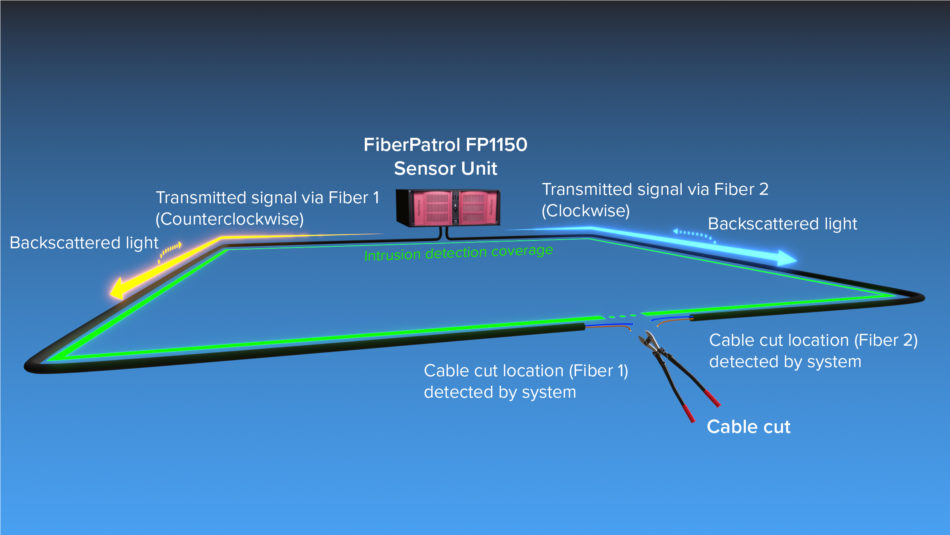How Fiber Security Helps Prevent Unauthorized Access and Improves Monitoring
How Fiber Security Helps Prevent Unauthorized Access and Improves Monitoring
Blog Article
The Ultimate Overview to Fiber Optic Security Systems for Your Organization
In a period where security problems are critical for organizations, comprehending the ins and outs of fiber optic modern technology can be transformative. This guide details how incorporating fiber optic safety systems not only improves data defense but additionally uses benefits like resistance to disturbance and real-time surveillance capabilities.
Recognizing Fiber Optic Technology

The core of a fiber optic cable contains a thin glass or plastic facility, surrounded by a cladding layer that shows light back into the core. fiber optic security system. This style makes certain minimal loss of signal toughness, even over considerable ranges. There are 2 primary types of fiber optic wires: single-mode and multi-mode. Single-mode fibers are developed for long-distance transmission, while multi-mode fibers appropriate for shorter distances, typically made use of within buildings.
Fiber optics are not just faster but additionally extra secure than standard circuitry. Their fundamental resistance to electro-magnetic disturbance and the difficulty of using the signal without discovery make them a recommended selection for organizations prioritizing information honesty and safety and security. As companies significantly rely upon safe and secure and reliable interaction systems, recognizing fiber optic innovation becomes vital for notified decision-making.
Key Advantages of Fiber Optic Safety
When taking into consideration safety options for a service, the benefits of fiber optic systems are specifically compelling. Most importantly, fiber optic innovation provides exceptional information transmission rates and data transfer capability, making it perfect for taking care of high-resolution video clip feeds from security cams. This capability ensures that safety and security employees get real-time information, boosting overall action times to possible security threats.
Additionally, fiber optic wires are naturally immune to electromagnetic disturbance, which can endanger the stability of typical copper-based systems. This resistance guarantees that the information transmitted remains protected and nonstop, supplying an extra reputable safety facilities. Furthermore, fiber optics are less vulnerable to physical damages, as they are made from glass as opposed to metal, lowering upkeep expenses and downtime.
Fiber optic systems supply boosted cybersecurity functions, consisting of file encryption abilities that protect delicate data from unapproved accessibility. Jointly, these advantages make fiber optic protection systems a durable option for companies looking for to enhance their safety and security procedures.
Installment Refine and Factors To Consider
Thinking about the intricacies entailed, the installation process of fiber optic protection systems requires careful planning and execution. The initial step involves a detailed website description evaluation to recognize optimum places for cabling and devices. This assessment ought to take into consideration ecological factors, existing facilities, and potential susceptabilities.

Additionally, the installation should comply with local building ordinance and industry standards. This might include coordinating with numerous stakeholders such as building managers, IT teams, and protection workers to make sure smooth combination with existing systems.
Post-installation, rigorous screening is needed to confirm system performance and identify any concerns that might develop. By focusing on these factors to consider throughout the installation process, companies can guarantee a durable and effective fiber optic safety system that meets their particular protection demands.
Most Recent Innovations in Fiber Optic Security
Recent improvements in fiber optic modern technology have significantly boosted the capabilities of safety and security systems for businesses. One of the most remarkable advancements is the assimilation of fiber optic sensors that can find resonances and intrusions along the boundary of a facility. These sensing units supply real-time surveillance, enabling rapid response to prospective violations.
Furthermore, the growth of distributed fiber optic sensing technology permits the constant monitoring of big locations with a single fiber cord. This approach not only decreases installation costs however also improves the integrity of monitoring systems by eliminating the requirement for several, different sensors.
Furthermore, developments in multiplexing strategies have made it possible for companies to transmit large quantities of data over site web fiber optic networks, boosting the capacities of video clip security systems. High-def video clip feeds can currently be sent out over fars away without loss of top quality, guaranteeing that security workers have access to clear and actionable details.
Finally, the use of artificial knowledge (AI) along with fiber optic systems is transforming hazard discovery. AI formulas can examine information from fiber optic networks to identify uncommon patterns or behaviors, allowing for positive safety and security actions. These advancements collectively represent a significant jump onward in fiber optic safety innovation.
Picking the Right System for Your Service
Choosing the proper fiber optic safety and security system for your organization is essential for guaranteeing ideal security and assurance. To make an enlightened selection, analyze your specific protection demands, considering variables such as the you could check here dimension of your properties, the nature of your procedures, and prospective vulnerabilities.
Begin by reviewing the degree of security called for; as an example, risky atmospheres might demand advanced systems with integrated surveillance and invasion discovery capabilities. Next off, think about scalability; as your organization expands, your protection system should be qualified of broadening to suit increased demands without substantial overhauls.
Furthermore, examine the reliability and performance of different systems. Look for providers with well established online reputations and client testimonials that vouch for their solution top quality. It's also a good idea to ask about the technology's compatibility with existing framework, ensuring a seamless combination process.
Final Thought
In final thought, fiber optic security systems provide a durable service for boosting service security frameworks. The newest technologies further bolster the effectiveness of these systems, guaranteeing that organizations stay safe and secure and versatile in an ever-evolving risk landscape.
Report this page